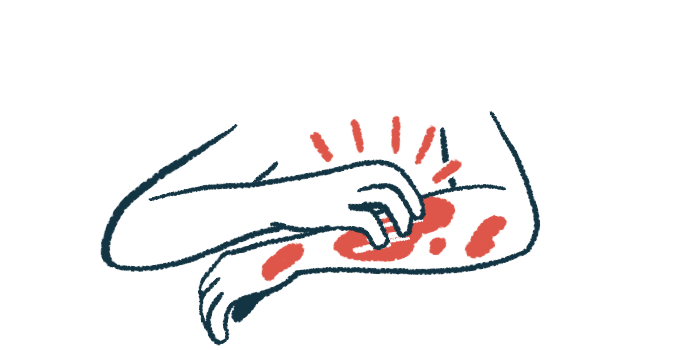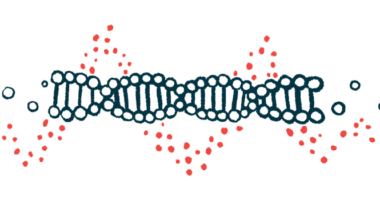Dupilumab treatment eases disease severity, itching in DEB: Small study
Benefits maintained in woman who stopped therapy before she got pregnant

Treatment with dupilumab, a medicine approved for certain inflammatory disorders, eases itch and disease severity in people with different subtypes of dystrophic epidermolysis bullosa (DEB), a small study suggests.
Dupilumab-related benefits seen in a woman before she stopped treatment and got pregnant were mostly maintained throughout her pregnancy and childbirth. Treatment had no impact on conception or on the woman’s health or her infant’s, according to researchers.
The study, “Efficacy and Safety of Dupilumab Monotherapy in Patients With Dystrophic Epidermolysis Bullosa: A Retrospective Study of 8 Cases,” was published in The Journal of Dermatology.
Dupilumab treatment designed to block key protein’s activity
All types of DEB are caused by mutations in the COL7A1 gene, which disrupts the production of collagen, a protein that gives structure to tissues and organs, including the skin. When this collagen is faulty, skin layers easily tear, leading to blisters and scarring. Depending on the extent of collagen deficiency, DEB is categorized as mild to severe.
In addition to skin wounds, people with DEB experience symptoms such as severe pruritus, or itching, which is challenging to manage and significantly affects quality of life.
Dupilumab is designed to block the activity of interleukin-4, an inflammatory signaling protein that plays a role in certain types of immune responses, including allergic reactions. The therapy is approved under the brand name Dupixent for certain inflammatory conditions, including atopic dermatitis, or eczema.
In a recent small study out of Germany, dupilumab eased itching, reduced blisters, and improved quality of life in 11 people with different types of epidermolysis bullosa, including DEB.
In the new study, a research team in China retrospectively evaluated the efficacy and safety of dupilumab as a single therapy in eight DEB patients, ages 5 to 38, with severe pruritus.
Four participants were diagnosed with severe recessive DEB, two had intermediate recessive DEB, one had recessive DEB pruriginosa, and another had dominant DEB pruriginosa. Recessive DEB means having two copies of disease-causing mutations, one from each parent, whereas dominant DEB develops if a person inherits a single copy of the disease-causing mutation that’s sufficient to cause disease.
In all cases, itching was unresponsive to conventional treatments for at least a year.
Mean score for itching drops significantly
Dupilumab was given by under-the-skin, or subcutaneous, injection, starting with a 300 or 600 mg dose followed by regular 300 mg doses.
DEB severity was assessed using the Birmingham Epidermolysis Bullosa Severity (BEBS) score. Pruritus was measured by a numerical rating scale (NRS) from 0 to 10, with higher scores indicating worse itching. Before treatment, which was used as the baseline, the mean NRS score for itching was 8.75.
Following dupilumab treatment, the mean NRS score for itching dropped significantly to 3.63 at four weeks (58.5% reduction), 3.5 at eight weeks (60% reduction), and 4.38 at 12 weeks (49.9% reduction). Six patients achieved an NRS score reduction of at least 3.8 points.
At baseline, the mean BEBS score for DEB severity was 35.36 out of a total possible score of 100. After 12 weeks of dupilumab, the mean score decreased to 27.48, representing a 22.3% improvement. At the same time, the mean score of areas of skin damage improved by 31.2%.
Despite these benefits, eye, esophagus, larynx (voice box), or toenail involvement was not improved, nor was hand scarring or hair loss (alopecia).
“The persistent clinical burden in these domains, despite systemic therapy, suggests either delayed therapeutic effects or intrinsic resistance mechanisms requiring long-term follow-up in these patients,” the team wrote.
Conception, health of mother and child not affected
A 26-year-old woman with DEB pruriginosa discontinued treatment after 16 weeks when she was trying to get pregnant. While some rash and itching recurred six months later, the dupilumab-related improvements seen before she stopped treatment were maintained throughout her pregnancy and childbirth.
Four children with severe or intermediate DEB stopped dupilumab treatment due to a partial response after 12 or 20 weeks.
Among those who continued beyond 12 weeks, a 38-year-old woman with DEB pruriginosa went from dosing every two weeks to every eight weeks without experiencing recurrent pruritus or lesions. A 10-year-old boy with severe DEB stayed on treatment because his persistent oral blisters and nutritional status continued to improve.
Our study provides preliminary evidence supporting the use of Dupilumab as a potential treatment option for DEB patients.
A 9-year-old boy with severe DEB had an unhealed chronic facial wound for one year due to pruritus and scratching. After six months of dupilumab, the chronic facial wound healed, and the itching was relieved despite the occasional skin blister. He eventually stopped treatment after 2.5 years, but 4.5 months later, he developed more skin blisters and itching. Still, the symptoms were milder than before treatment.
“Our study provides preliminary evidence supporting the use of Dupilumab as a potential treatment option for DEB patients,” the researchers concluded. “Future research should expand on these findings and further elucidate the mechanisms of dupilumab in [DEB] pruritus management.”








